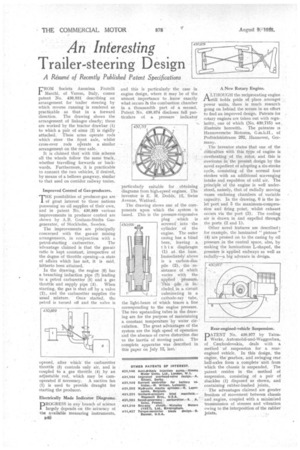An Interesting Trailer-steering Design
Page 46

If you've noticed an error in this article please click here to report it so we can fix it.
A Résumé of Recently Published Patent Specifications
FROM Societa. Anonima Fratelli Macchi. of Varese; Italy, comes patent No. 430,931 describing an arrangement for trailer steering by which reverse running is rendered as practicable as that in a forward direction. The drawing shows the arrangement of linkages clearly; these are worked by the tractor drawbar. (1) to _which a pair of arms (2) is rigidly attached.. These arms operate rods which steer the front axle, whilst cross-over rods oPerate a similar arrangement on the Tear axle,
It is claimed that with this scheme all the wheels follow the same track, whether travelling forwards or backwards. Furthermore, it is practicable to connect the two vehicles, if desired, by means of a bellows gangway, similar to that used on corridor railway trains.
Improved Control of Gas-producers.
THE possibilitiesof producer-gas are of great interest to those nations possessing no oil supplies of their own, and in patent No. 430,889 various improvements in producer control are shown by A.B. Graham-Stedts Gasgenerator, of Stockholm, Sweden.
The improvements are principally concerned with the gas-air mixing arrangements, in conjunction with a petrol-starting carburetter. The advantage claimed is that the gas-air ratio is kept constant, irrespective of the degree of throttle opening—a state of affairs which has not, it is said, hitherto been' attained.
In the drawing, the engine (6) has a branching induction pipe (7) leading to a petrol carburetter (5) and a gas throttle and supply pipe (3). When starting, the gas 'is shut off by a valve (2), and the carburetter supplies the
usual . mixture. Once started, the petrol is turned off and the valve is
opened, after which the carburetter throttle (5) controls only air, and is coupled to a gas throttle (9) by an adjustable rod, which may be camoperated if necessary. A suction fan (I) is used to provide draught for starting the producer.
Electrically Made Indicator Diagram&
DROGRESS in any branch of science I largely depends on the -accuracy of the available measuring instruments,
and this is particularly the case in engine design, where it may be of the utmost importance to know exactly what occurs is the combustion chamber in a. thousandth part of a second. Patent No. 430,974 discloses full particulars of a pressure indicate)r particularly suitable for obtaining diagrams from high-speed engines. The inventor is E. M. Dodds, 12, Swiss Avenue, Watford.
The drawing shows one of the components upon which the system is based. This is the pressure-responsive plug which is screwed . into " the cylinder of the engine. The outer casing has a blind bore, leaving a thin diaphragm (1) at the base. Immediately above is a carbon-disc pile (2), the resistance of which varies with theapplied pressure. .. pressure. .. This pile iS eluded in a circuit culminating in a . cathode-ray tube, the light-beam of which traces a line corresponding to the engine pressure.
The two upstanding tubes in the drawing are for the purpose of maintaining a constant temperature by water circulation. The great adira,ntages of the system are the high speed of operation and the absence of curve distortion due to the inertia of moving parts. The complete apparatus was described in this paper on July 12, last. A New Rotary Engine.
ALTHOUGH the reciprocating engine still holds pride of place amongst power units, there is much research going on behind the scenes in an effort to find an improved design. Patents for rotary engines are taken out with regularity-, one Of which (No. 430,715) we illustrate herewith. The patentee is Hannoversche lVfotoren, Gaid.b.H., of Podbielskistrasse 292, Hannover, Ger
many. .
.The inventor states that one of the difficulties with this type of engine is overheating of.. the rotor, and this is overcome in the present design by the novel expedient of adopting a six-stroke cycle, consisting of the normal four strokes with an additional scavenging intake and expulsion of cold air. The principle of the 'engine is well understood, namely, that of radially moving vanes enclosing chambers of variable capacity. In the drawing, 6 is the inlet "port and 5 the maximum-compression and firing 'point, whilst exhaust occurs via the port (3). The cooling air is drawn in and expelled through the ports (2 and 1).
Other novel features are described; for example, the laminated "pistons " (4) are presSed on to the casing by oil pressure in the central space, also, by making the laminations L-shaped, the pressure is applied endways as well as radially—a big advance in design.
Rear-engined-vehicle Suspension.
DATE/s•TT No. 430,977 by Tatra1 Werke, Automobil-und-Waggonbau, of Czechoslovakia, deals with a method of suspension for a rear. engined vehicle. In this design, the engine, the gearbox, and swinging rear. half-axles form a complete unit from which the chassis is suspended. The patent resides in the method of suspension, consisting of a pair of shackles (1) disposed as shown, and containing rubber-bushed joints., " The advantages claimed are greater freedom of movement between chassis and engine, coupled with a minimized transmission of stresses and vibration owing to the interposition of the rubber joints.












































































